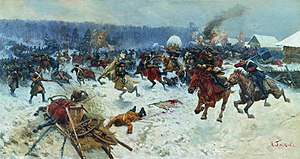Battle_of_Erastfer
Battle of Erastfer
1701 battle during the Great Northern War
The Battle of Erastfer (also Battle of Errestfer, Battle of Erastvere) took place on 29 December 1701 (O.S.) / 30 December 1701 (Swedish calendar) / 9 January / 1702 (N.S.) near Erastfer in eastern Swedish Livonia (present-day Erastvere in Estonia) between a Russian force of around 13,000 regulars along with 6,000 irregulars led by general Boris Sheremetev[3] and a Swedish force of about 3,470 men (at least 1,000 men were absent from the ranks for various reasons on the day of the battle, resulting in an actual fighting force of about 2,200–2,470 men), under the command of Wolmar Anton von Schlippenbach.[1] The Swedes were defeated, with a loss of 1,000 men killed and captured along with all their artillery pieces.[4] The Russians sustained about 1,000 killed[3] along with another 2,000 wounded (according to a Russian soldier who later admitted, after being captured by the Swedes, to 3,000 total losses).[4]
